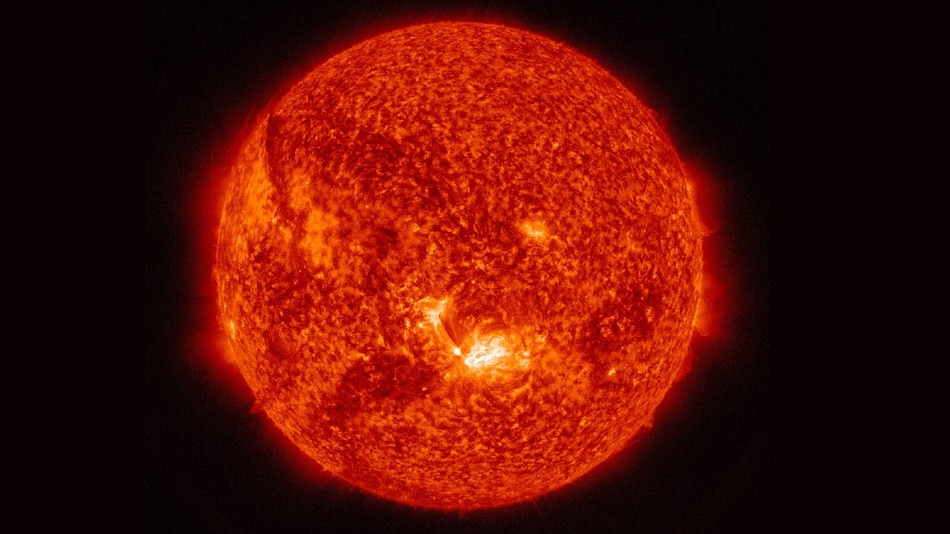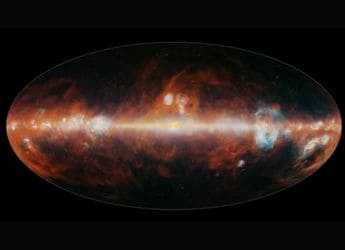- Home
- Science
- Science News
- Geomagnetic Solar Storm to Hit Earth on April 14, May Cause Possible Damage
Geomagnetic Solar Storm to Hit Earth on April 14, May Cause Possible Damage
NASA and National Oceanic and Atmospheric Administration (NOAA) forecasted that the most impactful storm will affect Earth on April 14.

Photo Credit: NASA
This solar storm might disrupt Earth's electricity grids and other resources
Scientists are expecting a major solar storm to hit the Earth on April 14. This event could cause possible damage to Earth, researchers suggest. Space agencies say that this geomagnetic solar storm could be particularly powerful as the Sun has been quite active lately. Recently, the Sun has been flaring up more. This is because it is approaching its Solar Maxima in its 11-year solar cycle. Solar maxima is the time of greatest activity during the solar cycle. As a result, the Sun has been flaring up with Coronal Mass Ejections (CME) more frequently in the past few months.
Most of these solar flares did not reach Earth but a few of them did erupt in our planet's direction. This has been causing a few geomagnetic storms already.
NASA and the National Oceanic and Atmospheric Administration (NOAA) have been actively monitoring the Sun's frequent CME flares. They have forecast that the most impactful storm will affect Earth on April 14. This time, the solar flares will have an extremely rapid wind stream. Hence, NASA has predicted that there are high chances that the storm will intensify after striking the Earth.
In a tweet, the Centre of Excellence in Space Sciences India (CESSI) wrote, “Our model fit indicates a very high probability of Earth impact on April 14, 2022, with speeds ranging between 429 to 575 kilometres per second. Low to Moderate geomagnetic perturbations are expected.”
It added, “Currently, solar wind and near-Earth space environmental conditions are returning to nominal levels.”
//CESSI SPACE WEATHER BULLETIN//11 April 2022//SUMMARY: QUIET TO MODERATE SPACE WEATHER CONDITIONS// A halo CME was detected by SOHO LASCO on 11 April. Our model fit indicates a very high probability of Earth impact on 14 April, 2022 with speeds ranging between 429-575 km/s + pic.twitter.com/MRFNuLI2hS
— Center of Excellence in Space Sciences India (@cessi_iiserkol) April 11, 2022
Regular bursts are caused by magnetic activity on the outermost layer of the Sun's atmosphere. Plasma and magnetic fields are ejected into space as a result of this. A geomagnetic storm occurs when a CME collides with the Earth's magnetic field.
This solar storm might disrupt Earth's electricity grids and other resources. Higher latitudes are predicted to be impacted more than lower latitudes. Power outages and radio signal disruption are also possible in mid-latitude areas.
Get your daily dose of tech news, reviews, and insights, in under 80 characters on Gadgets 360 Turbo. Connect with fellow tech lovers on our Forum. Follow us on X, Facebook, WhatsApp, Threads and Google News for instant updates. Catch all the action on our YouTube channel.
Related Stories
- Samsung Galaxy Unpacked 2025
- ChatGPT
- Redmi Note 14 Pro+
- iPhone 16
- Apple Vision Pro
- Oneplus 12
- OnePlus Nord CE 3 Lite 5G
- iPhone 13
- Xiaomi 14 Pro
- Oppo Find N3
- Tecno Spark Go (2023)
- Realme V30
- Best Phones Under 25000
- Samsung Galaxy S24 Series
- Cryptocurrency
- iQoo 12
- Samsung Galaxy S24 Ultra
- Giottus
- Samsung Galaxy Z Flip 5
- Apple 'Scary Fast'
- Housefull 5
- GoPro Hero 12 Black Review
- Invincible Season 2
- JioGlass
- HD Ready TV
- Laptop Under 50000
- Smartwatch Under 10000
- Latest Mobile Phones
- Compare Phones
- Huawei Nova 15
- Huawei Nova 15 Pro
- Huawei Nova 15 Ultra
- OnePlus 15R
- Realme Narzo 90x 5G
- Realme Narzo 90 5G
- Vivo S50 Pro Mini
- Vivo S50
- Asus ProArt P16
- MacBook Pro 14-inch (M5, 2025)
- Huawei MatePad 11.5 (2026)
- OnePlus Pad Go 2 (5G)
- OnePlus Watch Lite
- Just Corseca Skywatch Pro
- Acerpure Nitro Z Series 100-inch QLED TV
- Samsung 43 Inch LED Ultra HD (4K) Smart TV (UA43UE81AFULXL)
- Asus ROG Ally
- Nintendo Switch Lite
- Haier 1.6 Ton 5 Star Inverter Split AC (HSU19G-MZAID5BN-INV)
- Haier 1.6 Ton 5 Star Inverter Split AC (HSU19G-MZAIM5BN-INV)

















